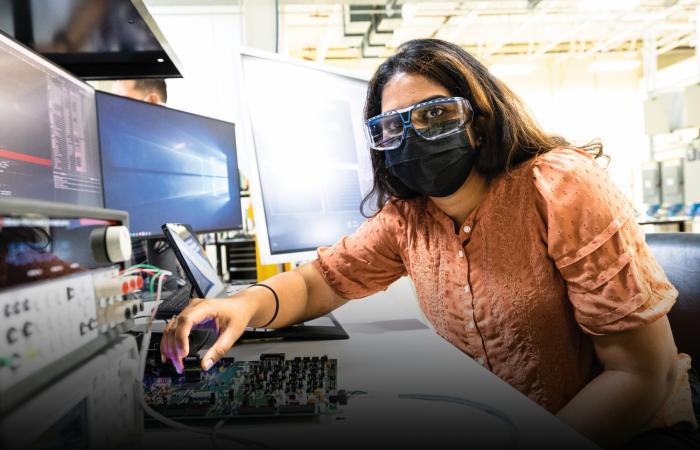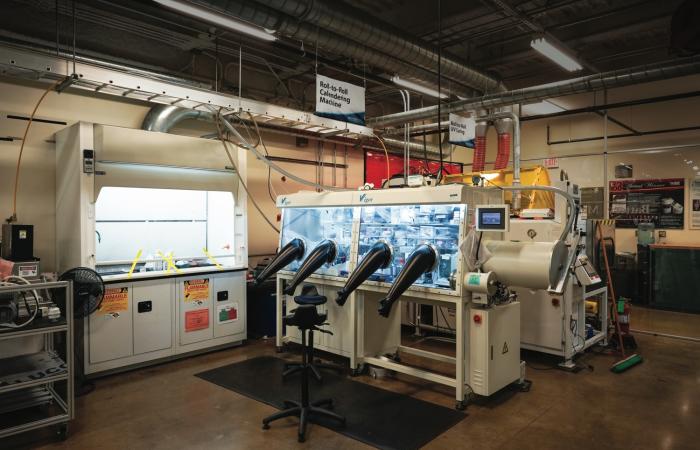The Grid Research Integration and Deployment Center, or GRID-C, is a 52,000-square-foot facility located in Hardin Valley, about eight miles from ORNL’s main campus.
It pulls together ORNL’s work in electricity, from ensuring the safety and stability of America’s electric grid, to doing the same for neighborhood-wide microgrids, to developing future battery technologies that will enable battery-powered cars and trucks and, eventually, battery-powered aircraft. The center takes advantage of ORNL’s world-class expertise in power electronics, creating new devices from concept to deployment across grid, energy storage, mobility and buildings applications.
“A lot of the work within the lab’s grid modernization R&D program is being pulled under one roof,” explained Tom King, who manages ORNL’s sustainable electricity program. “Geography makes a big difference in where people are located. If you’re looking at integration of a system of systems, being able to do that under one roof is imperative.”
GRID-C has dedicated areas for a dozen research and development areas related to the power grid and electric vehicles. These include:
- Cybersecurity research into secure, resilient grid communications architectures
- A Grid Operations Analytics Laboratory that simulates control room operation and incorporates cybersecurity and physical security, sensors, modeling and data analytics
- Grid simulation, including controls hardware, software platform integration and large-scale system emulation and protection
- Advanced sensors research
- Critical materials recovery and reuse
- Distribution-scale grid research, including power electronics and energy storage
- Vehicle systems and electric drivetrain evaluation
- A Battery Manufacturing Facility that will provide open access to areas from materials synthesis to prototyping of vehicle and grid-level battery systems
- A residential-scale grid to emulate homes and neighborhoods and test grid interaction
- Vehicle-to-grid charging and systems integration, which will explore extreme-fast wired and wireless vehicle charging
- High-voltage research
- Advanced component development
“Everything ties to the grid: buildings, vehicles, chargers, everything,” said Power Electronics Systems Integration Group Leader Madhu Chinthavali. “To understand how they interact, we need a facility where we can emulate them and put our developments to the test.”
As an example, Chinthavali pointed to a fast charger his group is developing using advanced components that are not commercially available. The availability of charging systems at 120, 240 and 480 volts is critical to judging these components.
“We want to test them, evaluate them and show how different they are,” he said, “in terms of efficiency, functionality, and size, weight and volume. For that I need a lab to test it.”
Chinthavali also stressed GRID-C’s value as a place where industry collaborators can tap into both the experimental equipment and the expertise of ORNL staff in battery technology and grid research.
“Say I’m a hardware vendor who has an extreme fast charger,” he said. “We can bring those vendors into this facility, they can tie to the ecosystem, understand the grid interaction with it.”
These resources are especially important for business startups that have great ideas but little money, Chinthavalli stressed. ORNL has various funding mechanisms for giving these businesses access to facilities and equipment they could not afford on their own. As such, ORNL is helping them through the “valley of death” between prototypes and commercial-scale technologies.
“This should be a system where we help the startups to cross the ‘valley of death,’” he said. “To put up hardware systems like this takes millions and millions of dollars. If they have an idea, they should be able to incubate with us and transform their technology enough to show mass production out of this building.”
King agreed that GRID-C opens up opportunities for collaboration, pointing to ORNL’s work with Chattanooga, Tennessee’s Electric Power Board on small neighborhood-sized grids called microgrids.
“Company partners like EPB will want to make sure that the approaches we’re taking aren’t going to have major negative impacts in the field,” he said. “And so if we work through the technical challenges within GRID-C, hopefully, it’ll be ready for field deployment.”






